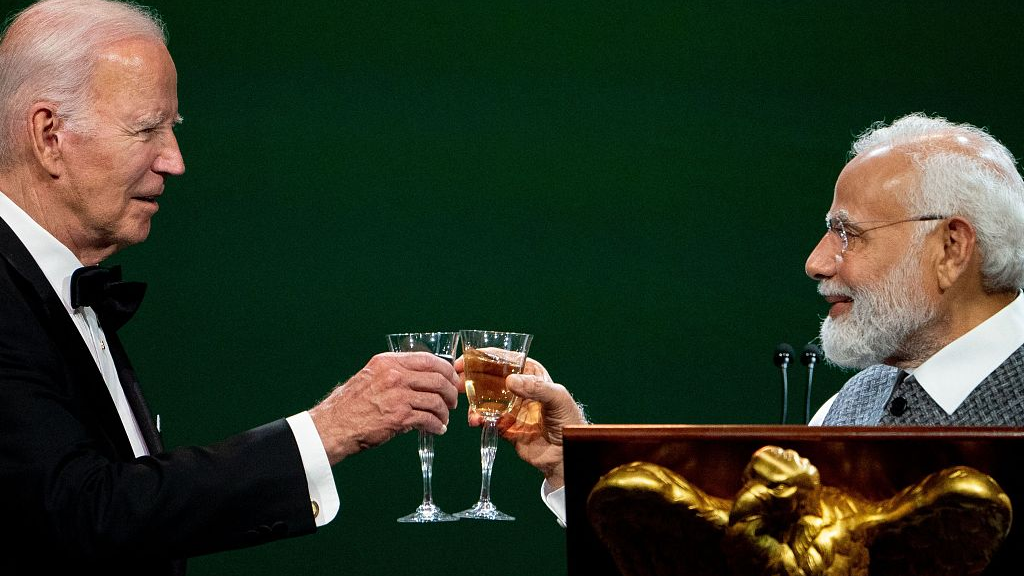
U.S. President Joe Biden and Indian Prime Minister Narendra Modi toast during an official State Dinner in honor of Modi, at the White House in Washington, D.C., U.S., June 22, 2023. /CFP
U.S. President Joe Biden and Indian Prime Minister Narendra Modi toast during an official State Dinner in honor of Modi, at the White House in Washington, D.C., U.S., June 22, 2023. /CFP
Editor's note: Qian Feng, a special commentator on current affairs for CGTN, is a senior research fellow at the National Strategic Institute, Tsinghua University, and Taihe Institute. The article reflects the author's opinions, and not necessarily the views of CGTN.
Indian Prime Minister Narendra Modi, who was once denied entry to the United States for "severe violations of religious freedom" in 2005, is now the brightest guest in the White House.
Modi left for the United States on June 20. This is his first "official state visit" to the U.S. although he has traveled there six times since he took office in 2014. Only heads of state, such as a monarch or president, can be invited for a "state visit." Before him, only former Indian Prime Minister Manmohan Singh had enjoyed the treatment.
Reviewers from both the U.S. and India said excitedly that Modi's visit was a turning point in bilateral relations. But everything has a reason. Washington intends to reduce India's dependence on Russia in military and defense. Russia has long been India's largest supplier of arms, which is clearly not in the interests of the U.S.
Since the conflict between Russia and Ukraine, India, instead of following the United States in imposing sanctions against Russia, has bought a lot of Russian energy, which makes the United States uncomfortable. According to an international arms sales report by the Stockholm International Peace Research Institute in 2022, India purchased 11 percent of the world's arms exports from 2018 to 2022, almost half of which came from Russia.

A pump jacks in an oil field developed by the Yamashneft Oil and Gas Production Division of Tatneft, in Almetyevsk District of Russia's Republic of Tatarstan, March 9, 2022. /CFP
A pump jacks in an oil field developed by the Yamashneft Oil and Gas Production Division of Tatneft, in Almetyevsk District of Russia's Republic of Tatarstan, March 9, 2022. /CFP
In the context of India's desire to improve its naval and air strength and realize weapons modernization, the United States is trying to provide it with advanced technology and diversified weapons options, to push India to reduce its dependence on Russian weapons, and gradually become an important market for American weapons.
Further, the U.S. administration is inciting India to counter China in the Asia-Pacific region. The U.S. also understands that India does not want to be a frontline country against China, but by selling India sophisticated weapons, such as MQ-9B drones, it can encourage India to increase its "confidence" in fighting China on the border.
At the same time, the United States is trying to deeply embed India in the "Indo-Pacific Strategy," improving the interoperability between the two countries in weapons technology systems to form a military deterrent against China.
In the past 20 years, the U.S. and India have accelerated their cooperation in defense and security in response to the so-called "China threat." Statistics show that defense trade between the two countries increased from near zero in 2008 to more than $20 billion in 2020. India bought defense products from the United States including P-8 long-range maritime patrol aircraft, AH-64 Apache helicopters, and C-130J transport aircraft.
Will Modi's visit become a turning point in U.S.-India relations? In fact, during former Indian Prime Minister Singh's visit to the United States, as well as U.S. Presidents George W. Bush's, Barack Obama's and Donald Trump's trips to India, the same question had been raised many times, but it is proven that India has its own interests. The higher the hope for Washington, the greater the disappointment.
Judging from the recent exchanges between the two sides, the relationship between the U.S. and India is not as close as what we see in their official statement. The U.S. indulges in more wishful thinking and India is not very enthusiastic about some proposals from the U.S.
India has already joined the Quad, but the United States is obviously unsatisfied and intends to invite India to join the "NATO Plus" mechanism, in an attempt to use the NATO framework to confront China and tie India to the American chariot. In response, Indian Foreign Minister Subrahmanyam Jaishankar has rejected the invitation.
In addition, India's minister for power and renewable energy Raj Kumar Singh also attacked the U.S. energy policy for hypocrisy over the "clean energy negotiations" and accused the U.S. of "protectionism."
On the issue of arms sales, not to mention the difficulty of the United States to replace Russia as the main partner of India's weapons defense, India has been seeking to localize defense production in recent years, seeking only the advanced military technology of the United States, rather than including its own weapon system in the U.S. camp. India also imported heavy Russian crude after the conflict, reaching a record high last October, making Russia India's largest oil supplier.
Therefore, India pays more attention to national interests and tries to work with both sides in the game of great power. It hopes to take advantage of great power competition to get tangible benefits and obtain the financial and technical support of the United States, but will not assume the obligation of an "ally."
(If you want to contribute and have specific expertise, please contact us at opinions@cgtn.com. Follow @thouse_opinions on Twitter to discover the latest commentaries in the CGTN Opinion Section.)